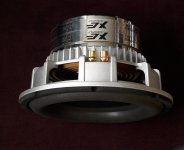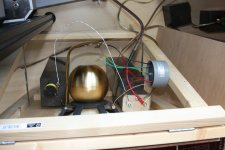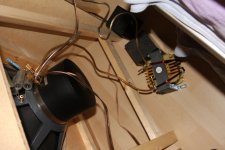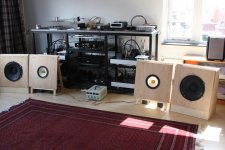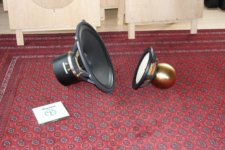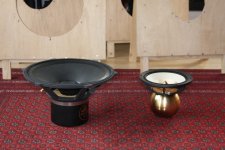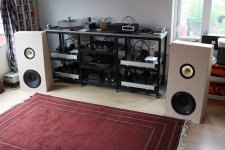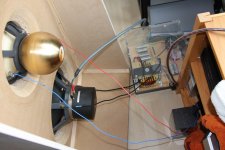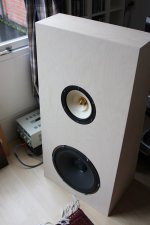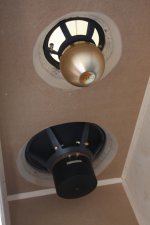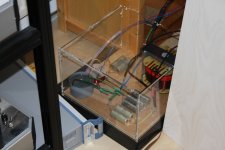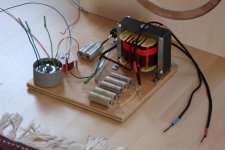Hi,
My question is if Jensen Field Coil speakers (12-15 inch) would do well in a open baffle.
These probably were used for Leslie guitars or Hammond organs, hence a dedicated purpose that might be far away from HiFi.
I have been triggered by some readings on the beautiful field coil speakers around, vintage (there seem to be a lot of Magnavox, Jensen Field Coil speakers around); new such as Supravox; and specialty shop products such as from Rullit.
I am contemplating to use the Jensen 12" as a bass/mid bass in an open baffle, supplemented with a proper fullrange for the top end. I was thinking Lowther, or what else.
The Jensens have a phenol spider, quite different from a normal pleated spider, that implies the dynamics go up. And dynamics, are what I am after, plus of course uncolored sound.
Loading the open baffle:
I think it was on Nelson Pass' site that I saw some arguments for a slot loading, a reasoning that made sense. The intent is to have a smaller surface on the front than on the back, this means the pressure is reduced on the back - if I recapitulate well this gives a nicer atmosphere. I would go for about half the surface on the front as on the back.
A 12 inch Jensen Field Coil will give about 95-98 dB of warm bass and lower midrange.
A smallish fullrange such as Lowther C45 can take the top, preferably from as low as possible, also providing 96 dB.
This could run happily on my Hiraga 8W, my F5 or my 300B (6-15 Watt).
My initial drawings for a baffle height of about 1 meter and a width of about 50-60 cm, the sides adding another 20 cm:
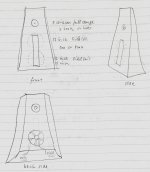

See f.e. JENSEN field coil speaker F15LL
I found this Jensen OB project that shows this frequency plot:
Well, that is not a straight line!! But I recognize the effects of a too small baffle also.
any ideas appreciated
albert
My question is if Jensen Field Coil speakers (12-15 inch) would do well in a open baffle.
These probably were used for Leslie guitars or Hammond organs, hence a dedicated purpose that might be far away from HiFi.
I have been triggered by some readings on the beautiful field coil speakers around, vintage (there seem to be a lot of Magnavox, Jensen Field Coil speakers around); new such as Supravox; and specialty shop products such as from Rullit.
I am contemplating to use the Jensen 12" as a bass/mid bass in an open baffle, supplemented with a proper fullrange for the top end. I was thinking Lowther, or what else.
The Jensens have a phenol spider, quite different from a normal pleated spider, that implies the dynamics go up. And dynamics, are what I am after, plus of course uncolored sound.
Loading the open baffle:
I think it was on Nelson Pass' site that I saw some arguments for a slot loading, a reasoning that made sense. The intent is to have a smaller surface on the front than on the back, this means the pressure is reduced on the back - if I recapitulate well this gives a nicer atmosphere. I would go for about half the surface on the front as on the back.
A 12 inch Jensen Field Coil will give about 95-98 dB of warm bass and lower midrange.
A smallish fullrange such as Lowther C45 can take the top, preferably from as low as possible, also providing 96 dB.
This could run happily on my Hiraga 8W, my F5 or my 300B (6-15 Watt).
My initial drawings for a baffle height of about 1 meter and a width of about 50-60 cm, the sides adding another 20 cm:


See f.e. JENSEN field coil speaker F15LL
I found this Jensen OB project that shows this frequency plot:
An externally hosted image should be here but it was not working when we last tested it.
Well, that is not a straight line!! But I recognize the effects of a too small baffle also.
- Is this type of speaker useful?
- Are these old trash speakers bound to start wobbling and rubbing the voice coil such that this would give a lot of pain? Better to use a modern speaker?
- Should I go for full mounting or is this slot idea good?
- Should I leave the fullrange wide open or roll it off a bit above its resonance?
any ideas appreciated
albert
Last edited:
Member
Joined 2009
Paid Member
Having read the thread about slot loaded OB's more than once I have become persuaded by the arguments made there by people who understand speakers well that it (the slot) doesn't provide any 'free lunch'. And given that you will use a sub, I would suggest that a simple 'traditional' OB design would be a better starting point, not least because if you are not sure about the results, you have one less variable to worry about. Where the slot loading seems to make sense is at lower frequencies, with the potential to reduce the amount of higher frequencies emitted (less distortion - a fact exploited by Tom Danley in his Synergy horn) and as you will use a sub I don't see that it makes sense.
I like the look of that driver. I've never heard a field-coil unit myself but they certainly have a good reputation for sound quality.
I like the look of that driver. I've never heard a field-coil unit myself but they certainly have a good reputation for sound quality.
Last edited:
Jensen not fit
I have simulated the Jensen in the Open Baffle program and this does show the unit has high efficiency, but that the low end is lacking compared to other drivers. The Jensen is more fit for a reflex enclosure probably.
Here is a simulation I ran:
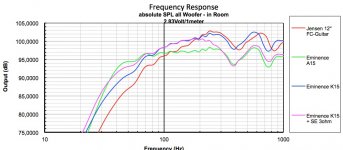
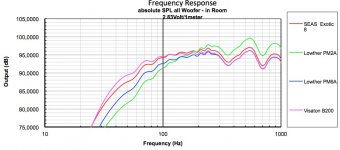
Re slot loading:
The slot loading can be done with the Eminence Kappa's and then the Q factor will rise to a very handsome level I expect, but I can't calculate just guestimate
albert
I have simulated the Jensen in the Open Baffle program and this does show the unit has high efficiency, but that the low end is lacking compared to other drivers. The Jensen is more fit for a reflex enclosure probably.
Here is a simulation I ran:

- It is clear that the low compliance of the Jensen FC is hindering performance. In fact (in theory) the 12" Jensen Field Coil performs is the 'worst' in this shoot-out in OB.
- The Eminence Alpha is the winner in smooth low end. E Kappa 15 with SE amplifier - an amplifier with a low damping factor - is not bad at all and just needs a slight lift that it can easily accommodate in power.

Re slot loading:
The slot loading can be done with the Eminence Kappa's and then the Q factor will rise to a very handsome level I expect, but I can't calculate just guestimate
albert
Open Baffle Option
This may not directly apply, but I think that there is reason for consideration. Go to the Decware Audio site, and look up the Open baffle design there. You will find that Steve Deckart, the designer, has made use of the hemholtz resonator tuned to a low frequency. It would be cool if that concept could be used in your project. Obviously changes would have to be made for your driver. Just a thought.
This may not directly apply, but I think that there is reason for consideration. Go to the Decware Audio site, and look up the Open baffle design there. You will find that Steve Deckart, the designer, has made use of the hemholtz resonator tuned to a low frequency. It would be cool if that concept could be used in your project. Obviously changes would have to be made for your driver. Just a thought.
super point source?
Thanks 4crow,
nice link.
Incredible driver that they have 4 an Open Baffle, at least there is a nice form factor: MODEL FRX2
This formula might be what I was looking for: it allows a calculation of the cavity and output slot! A horn uses a Helmholz resonator too doesn't it for the horn throat adaptation?
I tried a calculator in a first attempt, but the numbers are very high.
What I expect is to find the low-pass frequency of the slot and the influence of the cavity size on Qt. In the calculator, for something reasonable in size the resonance frequency in the calculus leads to e.g. 180 Hz. I am not sure if this is a sane outcome.
What am I doing wrong?
Albert
Thanks 4crow,
nice link.
Incredible driver that they have 4 an Open Baffle, at least there is a nice form factor: MODEL FRX2
This formula might be what I was looking for: it allows a calculation of the cavity and output slot! A horn uses a Helmholz resonator too doesn't it for the horn throat adaptation?
I tried a calculator in a first attempt, but the numbers are very high.
What I expect is to find the low-pass frequency of the slot and the influence of the cavity size on Qt. In the calculator, for something reasonable in size the resonance frequency in the calculus leads to e.g. 180 Hz. I am not sure if this is a sane outcome.
What am I doing wrong?

Albert
ongoing project...
Good evening Albert,
(i could switch to Dutch now but that would not be very polite to English readers....)
I noted your ideas on a fieldcoil woofer in an open box design. It is just what i did......
Started this year with 2 amazing Fertin 38EX 15" fieldcoil woofers (see pictures). I decided to pair them with fullrange drivers in a FAST-configuration. For the fullrange-units i opted for Feastrex D9NF-units.
A great advantage of the fieldcoil-woofers is that you can change the Qts. That's a great asset when you want to match the woofer to the open baffle (or other enclosure). Of course you'll sacrifice efficiency but with these units you'll always stay on the healthy side of 90 dB.
I'm still tinkering with the crossover. Currently i use an autoformer to level out the efficiency between the Feastrex and the Fertin. At this moment it is in a very simple 18 mm plywood construction just to see if/how it works. The actual (large) open baffles are already ordered but the holiday-season will stall their delivery. The open baffles will be made from 30 mm plywood + 18 mm chipboard + 25 mm MDF in order to suppres resonances.
When the project is ready i'll post it on this forum......
Rest of my equipment: self build turntable + self build tonearm (18") + self build power amplifiers (TB 3/1000 triodes) + self build DAC (TDA1541A with step-up transformers) + Gryphon preamp.
I will follow your thread and look forward to the next building phase.
Regards, Reinout
Good evening Albert,
(i could switch to Dutch now but that would not be very polite to English readers....)
I noted your ideas on a fieldcoil woofer in an open box design. It is just what i did......
Started this year with 2 amazing Fertin 38EX 15" fieldcoil woofers (see pictures). I decided to pair them with fullrange drivers in a FAST-configuration. For the fullrange-units i opted for Feastrex D9NF-units.
A great advantage of the fieldcoil-woofers is that you can change the Qts. That's a great asset when you want to match the woofer to the open baffle (or other enclosure). Of course you'll sacrifice efficiency but with these units you'll always stay on the healthy side of 90 dB.
I'm still tinkering with the crossover. Currently i use an autoformer to level out the efficiency between the Feastrex and the Fertin. At this moment it is in a very simple 18 mm plywood construction just to see if/how it works. The actual (large) open baffles are already ordered but the holiday-season will stall their delivery. The open baffles will be made from 30 mm plywood + 18 mm chipboard + 25 mm MDF in order to suppres resonances.
When the project is ready i'll post it on this forum......
Rest of my equipment: self build turntable + self build tonearm (18") + self build power amplifiers (TB 3/1000 triodes) + self build DAC (TDA1541A with step-up transformers) + Gryphon preamp.
I will follow your thread and look forward to the next building phase.
Regards, Reinout
Attachments
Good evening Albert,
(i could switch to Dutch now but that would not be very polite to English readers....)
I noted your ideas on a fieldcoil woofer in an open box design. It is just what i did......
A great advantage of the fieldcoil-woofers is that you can change the Qts. That's a great asset when you want to match the woofer to the open baffle (or other enclosure). Of course you'll sacrifice efficiency but with these units you'll always stay on the healthy side of 90 dB.
Rest of my equipment: self build turntable + self build tonearm (18") + self build power amplifiers (TB 3/1000 triodes) + self build DAC (TDA1541A with step-up transformers) + Gryphon preamp.
Regards, Reinout
Hi Reinout, looks like a marvelous setting.
Funny you have the TT disjoint from the arm. I once made an arm with two crossed springs (scheermesblaadjes) 5 cm before the shell, with a rigid pivot (only horizontal). Was big fun. Until one day my wife was cleaning and thought the arm should be straight
The variable Qts of the FC is indeed interesting, I will follow up that. This means the efficiency goes down but also the damping, hence the rendition of the lower (up?) and mid (down) bass changes. Only to be done on the ears.
albert
Linkwitz has a lot on dealing with OB in his Orion project. Specifically, how to determine the eq needed.
Good link, Linkwitz has always been very good at the filters.
In an OB a baffle step of just 6 dB at a variable Fc will work well too. I like the simpleness.
Good evening Albert,
(i could switch to Dutch now but that would not be very polite to English readers....)
I noted your ideas on a fieldcoil woofer in an open box design. It is just what i did......
Started this year with 2 amazing Fertin 38EX 15" fieldcoil woofers (see pictures). I decided to pair them with fullrange drivers in a FAST-configuration. For the fullrange-units i opted for Feastrex D9NF-units.
A great advantage of the fieldcoil-woofers is that you can change the Qts. That's a great asset when you want to match the woofer to the open baffle (or other enclosure). Of course you'll sacrifice efficiency but with these units you'll always stay on the healthy side of 90 dB.
I'm still tinkering with the crossover. Currently i use an autoformer to level out the efficiency between the Feastrex and the Fertin. At this moment it is in a very simple 18 mm plywood construction just to see if/how it works. The actual (large) open baffles are already ordered but the holiday-season will stall their delivery. The open baffles will be made from 30 mm plywood + 18 mm chipboard + 25 mm MDF in order to suppres resonances.
When the project is ready i'll post it on this forum......
Rest of my equipment: self build turntable + self build tonearm (18") + self build power amplifiers (TB 3/1000 triodes) + self build DAC (TDA1541A with step-up transformers) + Gryphon preamp.
I will follow your thread and look forward to the next building phase.
Regards, Reinout
Cool project, Reinout! And concidentally, I am also working on a project comprising the fabulous Fertin 38EX for bass duty! Baffle will be rather large, approximately 90 cm. wide and 150 cm. tall, sandwich construction with different materials, and a detachable panel for the mid-high drivers, with versions for both symetrical and assymetrical vertical driver mounts.
Fullrange drivers up for testing will be Fostex FE203, FE206ES-R, FE208ES-R (easy to swap as they all have the same chassis) Lowther field-coil, the new Fertin series 7 edgeless 8" field coil and, just for fun, a pair of vintage unused Coral Beta 8.
Cool project, Reinout! And concidentally, I am also working on a project comprising the fabulous Fertin 38EX for bass duty! Baffle will be rather large, approximately 90 cm. wide and 150 cm. tall, sandwich construction with different materials, and a detachable panel for the mid-high drivers, with versions for both symetrical and assymetrical vertical driver mounts.
Fullrange drivers up for testing will be Fostex FE203, FE206ES-R, FE208ES-R (easy to swap as they all have the same chassis) Lowther field-coil, the new Fertin series 7 edgeless 8" field coil and, just for fun, a pair of vintage unused Coral Beta 8.
Hi Pengesluk
I'm interested how changing the field coil driver voltage will influence the bass response. I expect similar effect as going to a 'soft tone' SET amplifier: extended bass, flatter, maybe some less resolution in the mid-bass.
Reinout, looks nice, those table legs. Excellent crossover components.
I sort of finalised my OB.
Lowther PM2A + Lomo 2A9 // RFT L3702 with a lowish series crossover. I use an L-PAD. (-8 dB, so a PM6 should work better but now I have this three-four meters of sound depth . . .)
a strange concoction, I assume . Bit these were collected in my dustbin.
I will post the build when finished - want to make a custom design with some elements from the art of building piano's and violins.
I have the wood.
At this moment I have common spruce, 60 years old. Spruce is well sounding, better than the multiplex panels or kitchen tops that tend to sound dull.
I sort of finalised my OB.
Lowther PM2A + Lomo 2A9 // RFT L3702 with a lowish series crossover. I use an L-PAD. (-8 dB, so a PM6 should work better but now I have this three-four meters of sound depth . . .)
a strange concoction, I assume . Bit these were collected in my dustbin.
I will post the build when finished - want to make a custom design with some elements from the art of building piano's and violins.
I have the wood.
At this moment I have common spruce, 60 years old. Spruce is well sounding, better than the multiplex panels or kitchen tops that tend to sound dull.
Good evening Triode-Al,
i do know the Lowther but the LOMO and RFT - bass units you have are new to me. Not by name but how they actually sound.
PLEASE start sending pictures to the thread ! It's Always nice to see more interesting systems and from what i read now you have an interesting system indeed.
My woodwork is more down-to-earth and not decennia old special wood. Just a logical combination of 3 different layers and of 3 different thickness (MDF / chipboard / multiplex). In total serious "dead" in order to smother the bass-vibrations which otherwise would interfere with the mid/high.
Reading your wood-idea it seems that you intend to allow vibration ?
Regards, Reinout
i do know the Lowther but the LOMO and RFT - bass units you have are new to me. Not by name but how they actually sound.
PLEASE start sending pictures to the thread ! It's Always nice to see more interesting systems and from what i read now you have an interesting system indeed.
My woodwork is more down-to-earth and not decennia old special wood. Just a logical combination of 3 different layers and of 3 different thickness (MDF / chipboard / multiplex). In total serious "dead" in order to smother the bass-vibrations which otherwise would interfere with the mid/high.
Reading your wood-idea it seems that you intend to allow vibration ?
Regards, Reinout
.....aaaarrgghh....forgot my own pictures.
Now included:
- the total set-up;
- back side of the OB (you can see the total thickness of the combined layers);
- the external crossovers.
Sorry for the inconvenience.
Regards, Reinout
Now included:
- the total set-up;
- back side of the OB (you can see the total thickness of the combined layers);
- the external crossovers.
Sorry for the inconvenience.
Regards, Reinout
Attachments
Good evening Triode-Al,
i do know the Lowther but the LOMO and RFT - bass units you have are new to me. Not by name but how they actually sound.
PLEASE start sending pictures to the thread ! It's Always nice to see more interesting systems and from what i read now you have an interesting system indeed.
My woodwork is more down-to-earth and not decennia old special wood. Just a logical combination of 3 different layers and of 3 different thickness (MDF / chipboard / multiplex). In total serious "dead" in order to smother the bass-vibrations which otherwise would interfere with the mid/high.
Reading your wood-idea it seems that you intend to allow vibration ?
Regards, Reinout
Yes, in fact, but "allow" is something else than 'fight it at all cost' (with sand-filled panels, you name it).
The wood I bought is wood for piano's and cello's. It is light (very low resin content) and still spruce (vurenhout). No one will think it correct, everyone thinks is in other directions.
But the panel I have now (boekenkast plank Lundia 40x90cm) does not resonate, only the one that is damaged , it has a spalt from a forced screw.
So my choice at the end did not go to a field coil (I found them to be too expensive) but I in the mean time have spent about € 700 on the woofers, so more than just a trifle.
The RFT, with a large Alnico and running 98 dB, was used for stage support - in cabinets with a semi back - and in organs - with an open back. With a resonance of 43 Hz and stiff surround they are great for OB. Combined with just the lowther it was warm, no harschness in the sound. But I thought it lacked some differentiation.
Then bought the Lomo's. Indeed. Almost the biggest Alnico ever made, it seems, and this large magnet gives it just the transparency of the Lowther in mid bass. However it is 16 ohms so I do have a problem in efficiency, when paralelling to the RFT.
Still puzzling.
But as such the combo has an infinite dark background from which the sound appears.
I'll post a picture next week.
I like the looks of your FR.
Yes, in fact, but "allow" is something else than 'fight it at all cost' (with sand-filled panels, you name it).
The wood I bought is wood for piano's and cello's. It is light (very low resin content) and still spruce (vurenhout). No one will think it correct, everyone thinks is in other directions.
But the panel I have now (boekenkast plank Lundia 40x90cm) does not resonate, only the one that is damaged , it has a spalt from a forced screw.
So my choice at the end did not go to a field coil (I found them to be too expensive) but I in the mean time have spent about € 700 on the woofers, so more than just a trifle.
The RFT, with a large Alnico and running 98 dB, was used for stage support - in cabinets with a semi back - and in organs - with an open back. With a resonance of 43 Hz and stiff surround they are great for OB. Combined with just the lowther it was warm, no harschness in the sound. But I thought it lacked some differentiation.
Then bought the Lomo's. Indeed. Almost the biggest Alnico ever made, it seems, and this large magnet gives it just the transparency of the Lowther in mid bass. However it is 16 ohms so I do have a problem in efficiency, when paralelling to the RFT.
Still puzzling.
But as such the combo has an infinite dark background from which the sound appears.
I'll post a picture next week.
I like the looks of your FR.
Tone wood is nothing new and you are NOT the only one thinking in this direction! Look at musical affairs.
very unfortunate that hans just passed away he and his partner cess pal IMO are the ones who have really used tone wood to good effect!
Now Field coil IMO can be the cream and top of the crop! but only when done well (goat leather and wood spiders) then you have something interesting to listen too very lively and realistic!
Lawrence
I have simulated the Jensen in the Open Baffle program ...
albert
Hello Albert,
Since I see you are still around (this thread started quite a few years ago!),
Could you share which Open Baffle program you were using?
I've been looking around, and some like The Edge, or ABC Dipole are available, but it doesn't look clean like the graphs you posted. MZ Speaker Designer has been "Coming soon" since it's beginning many years ago.
Thanks!
Tone wood is nothing new and you are NOT the only one thinking in this direction! Look at musical affairs.
very unfortunate that hans just passed away he and his partner cess pal IMO are the ones who have really used tone wood to good effect!
Now Field coil IMO can be the cream and top of the crop! but only when done well (goat leather and wood spiders) then you have something interesting to listen too very lively and realistic!
Lawrence
Thanks,
Well, of course I saw Hans Kortenbach 's developments and loved his dedication. Sorry to hear he passed away. He was my inspiration to contact the firm of Tonewood in Bergün, the town where we have several times spent our summer vacation.
Of course Hans Kortenbach of Musical Affairs 's work was great, choice of drivers and execution of enclosures, though I have only seen it on the web.
I still have the work to be done. I have heard the wood resonate at a specific length and thickness and I need to find the right length that gives a harmonic - this is what I think now.
It is more complicated than just glueing parts together.
I now use a Lomo Kinap 2A9 combo that is very life-like , topped with a Lowther.
The 2A9 has the biggest or second to biggest Alnico magnet on the market, although I bet it does not quite get to 99 dB but I expect it is as strong as field coil assemblies. Modern designs made specifically for open baffle (with a high Q) will sound better in its balanced resonance and damping. But for me it is the human voice that counts: does the singer and performer stand in the room? In my appartmet the lowest tones have to be reduced anyway.
Just for fun, some ten years ago, I made a 8" speaker with a <1 mm pertinax center spider and normal leather (zeemleer, goat leather was too expensive at € 100 for a suitable piece), resulting in a resonance of 44 and 43 Hz, so I was good in my work, but I abandoned it for the 15 and 16" speakers. (If anyone is interested, for free ... contact me. They should be great in a horn. Almost 4 kg of magnet.
I just saw this build, these people are much smarter than I).
- Status
- This old topic is closed. If you want to reopen this topic, contact a moderator using the "Report Post" button.
- Home
- Loudspeakers
- Full Range
- Open Baffle with Field Coil speaker
